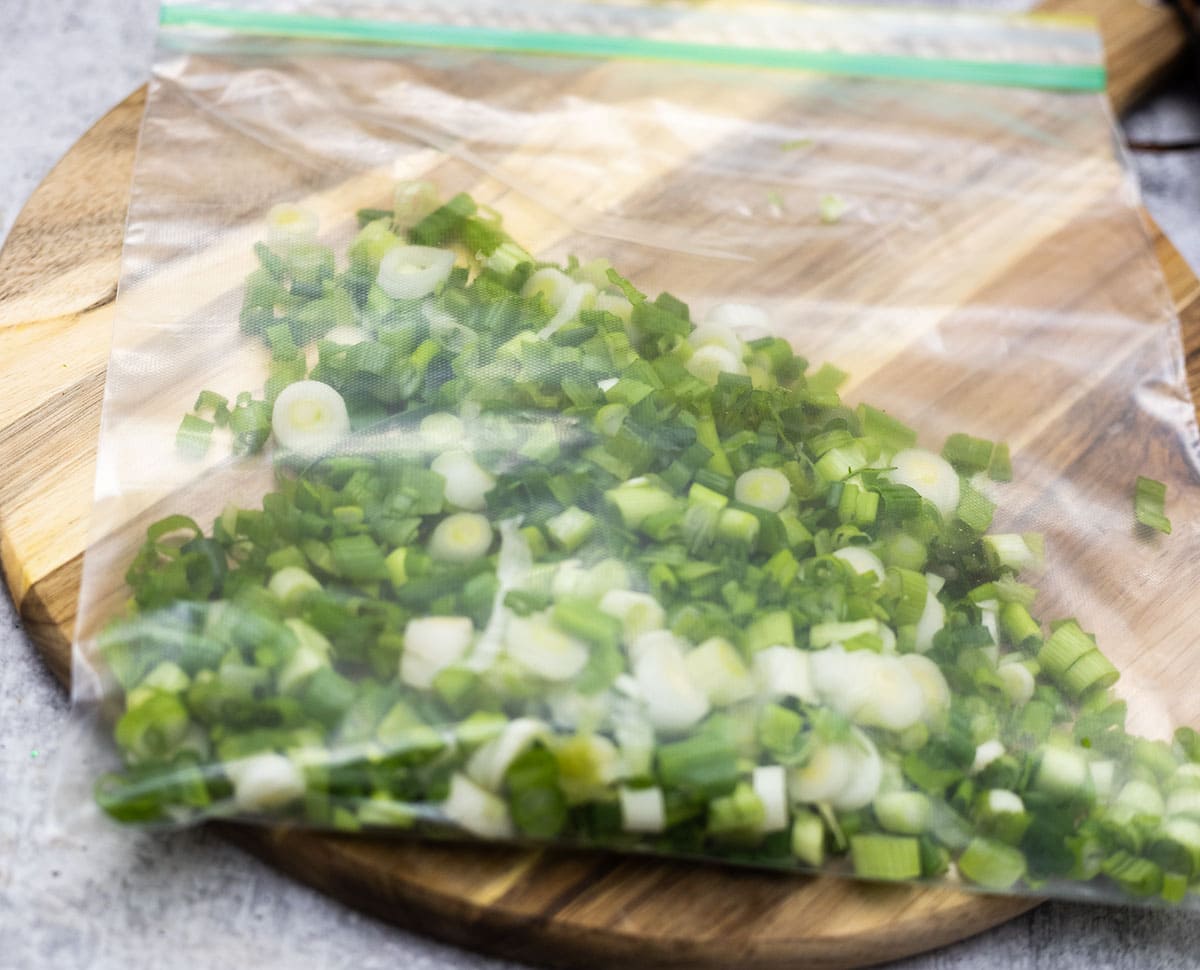How To Chop Green Onions
Learn how to chop green onions easily with this step by step tutorial! Also, you will find out the difference between a scallion and green onion.
I enjoy cooking with green onions; it is a must-have ingredient in most of my recipes, especially my Jamaican recipes.
Check out Chinese Scallion Pancakes, Plantain Fritters, Caribbean Green Seasoning, Jamaican Jerk Sauce.
Difference Between Scallion and Green Onion:
Scallions and green onions are our chosen alliums when we want a hit of less-intense onion flavors in our food. What are spring onions, however, and are they the same as scallions?
Speaking of which, are scallions and green onions similar?
The distinction between spring onions and scallions is challenging. Scallions are harvested at an earlier stage of their development, and are therefore younger than spring onions. You can easily distinguish between by the width of the white bulb at the base of the plant.

Green Onions vs. Scallions:
Probably, green onions and scallions are the same things! From the usual bulb-forming onions, we have firm stem ends harvested very young or can come from other varieties that never form bulbs.
Scallions are long, with a white end of the stem that is not bulging out. They have an oniony bite and aroma that is not as strong as regular onions, but mild (the white parts contain the most intense flavor).
They can be used raw or fried, and while some chefs discard the darker green tops, the whole thing can be eaten and often used in Asian cuisine.
Usually, scallions are available year-round. Look for a bright color, leaves that are undamaged, and firm stem ends.
What is Spring Onion, then?
On the other hand, spring onions look similar to scallions, except at the root, because you can recognize them as they have tiny onion bulbs.
These onions come from the bulb-producing varieties and are essentially more mature types of green onion. In fall, they are planted as seedlings and then harvested the next season, hence the word “spring” in the name.
Spring onions are sweeter and mellower than ordinary onions but more strong in taste than scallions and green onions.
Depending on the varietal, the bulbs can be red or white, and although they can be used in much the same way as standard bulb onions, they are perfect to fry, roast whole, or use like pearl onions.
Confusion Between Spring Onions and Green Onions:
There is always debate about whether or not green onions and spring onions are the same things. This may derive from the fact that green onions are called spring onions in other nations such as Canada and the United Kingdom.
Can I Use Spring Onions Instead of Scallions, or Vice Versa?
The intense flavors and textures of scallions and spring onions are similar, but bear in mind that the flavors’ strength is different.
If the onions are going to be left raw, I don’t suggest using spring onions instead of scallions, as spring onions have a more robust flavor.
However, if you intend on cooking the scallions or spring onions, then the cooking will mellow and even out the differences, so they’re reasonably replaceable for this use.
How to Chop Green Onions (Scallions):
The sharp taste of scallions is similar to regular onions. They are not as intense, however, and they will not make you tear up!
You’ve already eaten your fair share of scallions if you love Asian cuisine. In recipes including stir-fry, ramen, and scallion pancakes, these mixed veggies are also used. As the main ingredient or a garnish, they work well.
The green onion is edible—the white part, which is more intense than the green portion. While cooking green onions, many people trim and discard the tops and roots.
Different Ways to Slice the Green Onions or Scallions:
There are various ways to cut scallions; the best technique will depend on the dish you make.

1: Green Onion Coins or Ring-Like:
The first cut is as easy as it comes. This option produces tiny scallion “coins,” useful in cooked dishes as garnishes or adding a pop flavor.
Chop off the root end and the rough top portion of the green end using a large chef’s knife.
Line up the green onions and use a circular motion with your knife to slice them thinly.
Place green onions on a cutting board. Keep the green onion in place with your non-dominant side. Without pushing down, use your dominant hand to slide a sharp knife back and forth; this is the wise way to avoid crushing the green onion.
If green onions or scallions cut on the bias are needed by your recipe, position your knife at an angle, and repeat the same slicing motion.
Green onion slices should be around 1/8-inch thick when using this strategy. The size and shapes can be changed according to your needs.
2: Green Onion Hairs or Ribbon-Like:
The second method creates “hairs” of green onion. For salads or as a ramen garnish, this cut works well. Since the hair is so fine, it has a much less intense taste than other cuts.
To make this cut, slice the green onion extreme slant or diagonal. The knife needs to be approximately parallel to the scallion.
These beautiful spring onion hairs can be as dense or as thin as you would like. Don’t be afraid to experiment before the look you’re looking for is achieved.
Finally, in simple chunks, you can cut scallions. Those larger bits can be sliced for stir-fry dishes, and a diagonal or straight cut is best.
The length of the chunks should be around 1/4- to 1/2-inch. You’ll be ready to add them to your favorite recipes once you’ve learned how to cut scallions.
Keep it on a metal baking sheet lined with parchment paper to freeze the remaining cut green onion. Place onion in the freezer until they’re frozen. Store for 10 to 12 months in a freezer-safe bag.

3: Green Onion Brushes:
Do you ever order Peking duck in a Chinese restaurant and get a bowl of hoisin sauce served with some cute little spring onion brushes to paint the sauce on your pancakes? Those tiny brushes at home are super easy to make.
Start by cutting your green onion down to a length of around two 1/2-inches. Trim off the roots, as close as you can to the base.
With your non-knife hand, keep the green onion steady, position your knife parallel to the green onion and place the tip of your blade about an inch from the cut side. To split the end of the green onion in half, cut through.
Repeat the process by rotating the green onion a few times so that a total of four cuts have been made, breaking the green onion-end into eight separate parts.
In the refrigerator, move the brushes to a bowl of ice water and let them soak for at least 30 minutes and overnight to make them firm up and curl.
Green Onion Nutrition Facts:
Young onions, such as scallions, green onions, and spring onions, produce just around five calories per medium onion, 32 calories per 100 grams, and are very low in calories.
They are 89 percent water by fresh weight and pack 2.6 grams of fiber, 7.3 grams of carbs, and little protein and fat quantities per 100 grams.
Micronutrients, including folate and vitamins K and C, also comprise them.
Green Onions contain 100 grams of the following:
- Calories: 32
- Water: 89 percent
- Carbohydrates: 7.3 grams
- Sugar: 2.3 grams
- Fiber: 2.6 grams
- Fat: 0.2 grams
- Vitamin K: 173 percent of the Daily Intake of Reference (RDI)
- Vitamin C: 21% of the RDI
- Folate: 16% of the RDI
Such onions also boast beneficial antioxidants and compounds containing sulfur. Young onions, such as scallions, green onions, and spring onions, contain some fiber, carbs, and beneficial plant compounds, and are low in calories.
How to Cook with Scallions, Green Onions, and Spring Onions:
Although green onions and scallions are primarily classified by age, things can get confusing, as individuals sometimes use these words to describe any young onion interchangeably.
Therefore, determining the age and type of onion buying can be challenging.
However, the type doesn’t make much of a difference in dishes, as all young onions taste similar. It’s unlikely to mar your recipe if you’re uncertain the sort you have or worry you’ve got the wrong one.
There are common ways to prepare young onions in a salad or garnish, such as scallions, green onions, and spring onions.
By adding them to stir-fries, soups, and stews, you can cook with them as well. Spring onions taste fantastic pickled or grilled, with a slightly more robust flavor.
How to Store Green Onion or Scallions:
With deep green leaves and roots already attached, buy scallions. Avoid flimsy, slimy, discolored scallions.
When you bring scallions home, store them in the refrigerator. Place the scallions with a few inches of water in a jar for the best results.
You’ll want to make sure the bulbs and the roots are thoroughly immersed in water in a jar and container. With this method of storage, your scallions can stay in the refrigerator for 1 to 2 weeks.
How To Freeze Green Onions?
For longer storage, up to 3 months, slice green onions and place them in a freezer container. Store in the freezer.
Check Out Similar Posts Like This One!

If you enjoyed this post and would love to see more, join me on Youtube, Instagram, Facebook & Twitter!
Join Our Facebook Juice Support Group
Love seasonal recipes? Don’t miss out on my special offer for a limited time! Grab all three of my cookbooks for just $19.99! They’re filled with delicious, healthy dishes that are perfect for every season. Hurry and get your set before the offer ends!








This was very lovely to read, thank you for sharing!